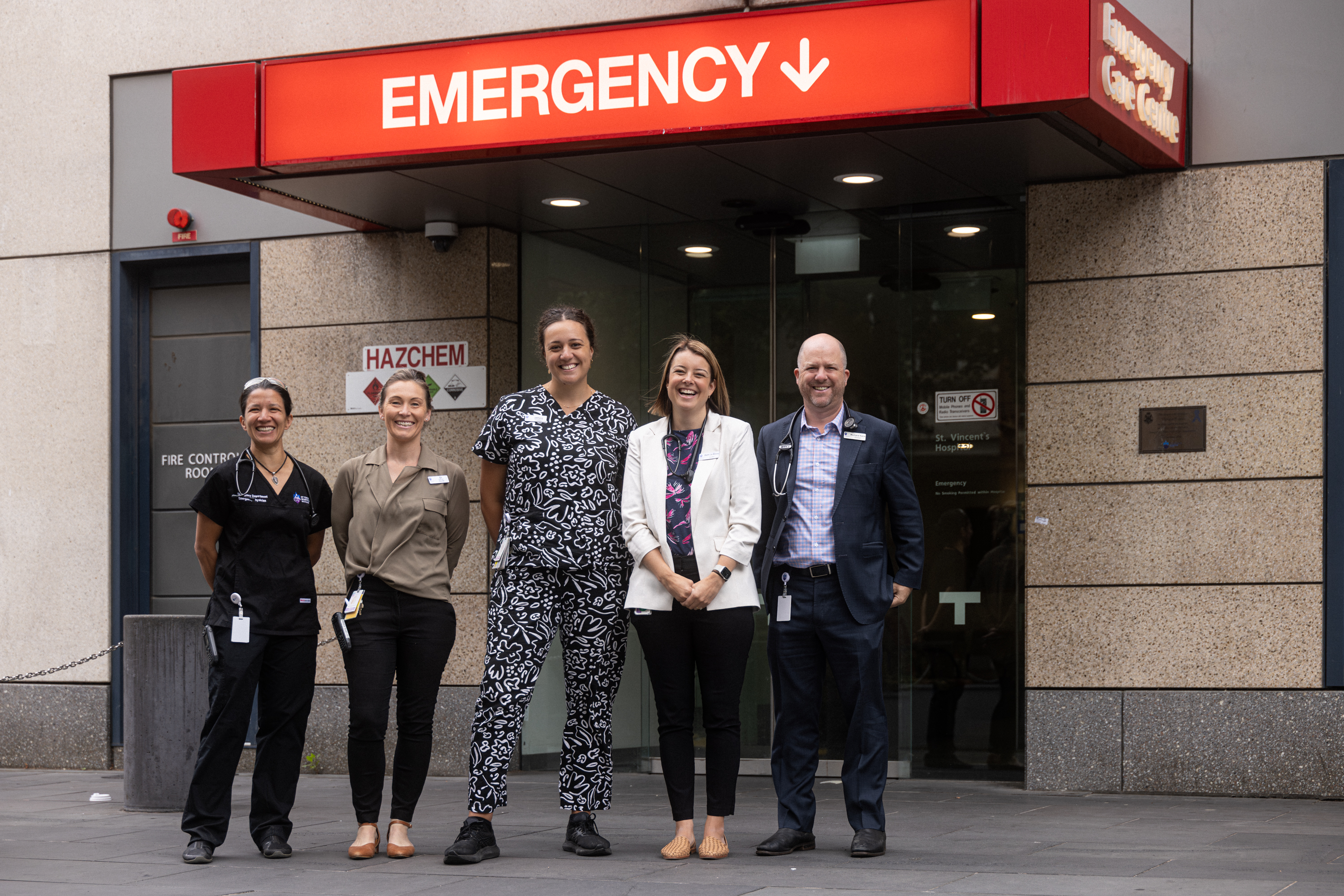Geriatricians in the ED: An innovative service that’s reducing hospital admissions
St Vincent’s Hospital Melbourne (SVHM) is transforming care for older people who present to the Emergency Department (ED), enabling many of these patients to avoid hospital admission.
SVHM’s Geriatrician in the Emergency Department (GED) initiative embeds geriatricians in the ED team to help determine the most appropriate care pathway for older patients. It is fast-tracking care for older Australians, reducing unnecessary hospital admissions and freeing up hospital beds for people of all ages.

SVHM Emergency Department team members A/Prof Nicola Cunningham, Di De Mack, Jakhana Day, Dr Beth La Brooy and Dr Richard Kane
Tackling a systemic challenge
Delivering appropriate and timely healthcare for older people is one of the biggest challenges facing Australia’s public health system. Older Australians make up 16% of the population but are responsible for between 40–50% of public hospital bed days, with emergency department visits by older people increasing by 30% during the past decade.
Across St Vincent’s hospitals nationwide, people aged 65 and over account for more than 490,330 bed days every year.
SVHM launched the GED service to provide timelier, more appropriate care for older people and the service has proven to be a game-changer when it comes to supporting older Australians to be cared for beyond hospital walls.
Transforming emergency care for older patients
During its initial 10 months, the GED program received 445 patient referrals. Of those, 58% were diverted from hospital admissions and treated at home or through community-based programs.
Dr Richard Kane, SVHM’s Clinical Director of Geriatric Medicine, said the GED service was a win for everyone.
“GED focuses on meeting patient care preferences, achieving better experiences and health outcomes, and creating more capacity for people who need in-hospital care,” Dr Kane said.
“Older patients often experience longer admissions and are more likely to encounter an adverse event, like a fall or an infection, while in hospital, and many older patients would prefer to receive their care at home.
“Geriatricians have specialist expertise and knowledge of healthcare pathways for older people, and work effectively with ED staff to identify the best care pathway for older patients – including when that’s outside the hospital.
“By having a Geriatrician in the ED for just a few hours each weekday morning, we’ve been able to safely divert almost 60% of older patients who ED staff were planning to admit to hospital.”
The GED service in action
Beverley, 85, is one of the many patients who has been able to avoid hospital admission, after she presented to SVHM’s ED with pain related to long-standing osteoarthritis.
Through referral to the GED Program, it was determined Beverley’s preference was to receive care at home and that, with appropriate support, this could be just as safe and effective as hospital care.
Beverley was then referred to SVHM’s GEM@Home service (Geriatric Evaluation and Management) and had daily visits from the team including doctors, nurses, physiotherapists, occupational therapists and social workers.
Her medications were adjusted as her pain improved and, ultimately, Beverley felt confident to remain at home. The GEM@Home team discharged her from the program with support services to help with tasks including shopping and cleaning, and plans for ongoing assessments.
A model for broader adoption
Dr Kane describes the GED model as simple but highly effective.
“The GED model takes a straightforward approach to a challenging issue that most Australian EDs and hospitals wrestle with; it’s a practical solution to a pressing problem, and we believe it can be adopted by hospitals across the country,” he said.
Initially funded through the Victorian Government’s Timely Emergency Care Collaborative, the GED program is now a permanent part of SVHM’s operations. SVHM plans to continue refining the service and looks forward to sharing its success with other healthcare providers who face similar challenges and helping reduce the growing demands on Australia’s healthcare system.